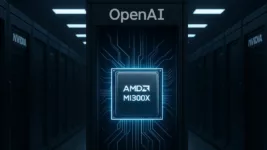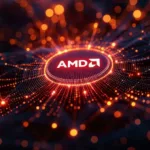In a significant shakeup of the AI hardware landscape, AMD has recently secured a major contract with OpenAI, signaling a shift in the high-stakes arms race for dominance in artificial intelligence infrastructure. The deal, rumored to include large-scale deployment of AMD’s MI300X and upcoming MI400 accelerators, positions AMD as a powerful alternative to NVIDIA’s near-monopoly in AI compute.
While full financial details remain undisclosed, insiders suggest the agreement involves a multi-billion-dollar commitment over several years, with OpenAI leveraging AMD’s GPUs across both inference and training workloads. The move underscores OpenAI’s growing appetite for diversification and hints at dissatisfaction with NVIDIA’s supply constraints, pricing strategies and closed ecosystem.
How This Puts AMD Ahead of NVIDIA’s Pending Deal
NVIDIA, long considered OpenAI’s closest hardware partner, has been in discussions for an extended renewal and expansion of their supply agreement. However, sources close to the talks indicate friction around costs and NVIDIA’s bundling practices, which often force cloud providers and AI labs to buy complete DGX systems rather than standalone GPUs.
By contrast, AMD has reportedly agreed to far more flexible licensing terms. AMD’s ROCm software stack, now mature and open-sourced, provides OpenAI with greater control, enabling them to fine-tune hardware-software alignment. This could tilt the scale in AMD’s favor, especially as OpenAI seeks to deepen vertical integration and potentially develop its own chips in-house.
AMD’s History as the Quiet Challenger
AMD has always played the underdog role—competing against Intel in CPUs and NVIDIA in GPUs for decades. Under the leadership of Dr. Lisa Su, AMD has methodically clawed market share across both fronts. First with the Zen architecture against Intel, then with CDNA and ROCm in AI compute, AMD has gone from being dismissed to dominating benchmarks and securing high-profile design wins.
This new OpenAI deal adds another major player to AMD’s growing list of customers—joining Microsoft Azure, Meta and Oracle—all of whom are already deploying MI300X or preparing for its successor.
How AMD Caught Up So Fast
NVIDIA had a ten-year head start in AI, but AMD has used three key strategies to close the gap quickly:
- Leverage of CPU+GPU integration – With EPYC and Instinct on the same board, AMD delivers dense, high-bandwidth compute nodes ideal for large AI models.
- Smart acquisitions – Xilinx and Pensando added vital IP around FPGAs and DPUs.
- Open collaboration – AMD actively works with the PyTorch and Hugging Face communities, optimizing performance across standard ML stacks.
Thanks to these efforts, AMD’s MI300X now matches or exceeds the H100 in many real-world inference workloads, making it a compelling alternative.
The Open-Source Advantage
Where NVIDIA locks customers into CUDA and closed software stacks, AMD offers transparency and openness. Their ROCm platform has become increasingly robust, supporting industry-standard frameworks and delivering near parity with CUDA on key benchmarks.
OpenAI, a long-time advocate of open research (before its partial shift to closed-source models), still relies heavily on open software workflows. AMD’s open ecosystem fits far more comfortably into that vision. Moreover, the ability to modify and adapt ROCm to its own needs gives OpenAI technical flexibility it could never get from NVIDIA.
NVIDIA’s Arrogance Is Catching Up
NVIDIA’s historic success has bred complacency and hubris. Jensen Huang’s company has repeatedly been accused of vendor lock-in, excessive pricing and squeezing smaller partners. As demand for H100s exploded, NVIDIA prioritized top-tier clients, leaving many cloud providers and labs scrambling.
Such behavior has alienated customers. AMD, in contrast, is taking the opposite route by working closely with partners, offering transparent roadmaps and delivering value-based pricing. OpenAI’s shift may be just the beginning of a broader customer exodus.
AI Market Bubble and the Looming Economic Downturn
It’s no secret that the AI market has reached fever-pitch levels of hype. With over $150 billion poured into AI startups since 2023 and GPU scarcity pushing data center budgets to extremes, many analysts believe the industry is nearing a saturation point. A market correction—or even a recession—could reset priorities toward cost-efficiency and ROI.
In that context, AMD’s competitive pricing and more flexible supply terms become not just attractive, but essential. The OpenAI deal may be the first of many such strategic moves as companies hedge against an over-concentrated, NVIDIA-dominated supply chain.
What’s Next for AMD in the AI Race?
Expect AMD to push aggressively on four fronts:
- MI400 Series Launch: Early 2026 will likely bring the MI400X with even more memory bandwidth and AI-dedicated tensor engines.
- AI Chiplet Customization: AMD may co-design chips with major customers, a la OpenAI, using modular chiplet architectures.
- ROCm Ecosystem Investment: Continued funding for open-source libraries, driver optimization, and developer tools.
- AI Software-as-a-Service: There are rumors AMD may partner with or acquire a small cloud AI platform to showcase ROCm performance at scale.
With momentum on their side and a long history of overcoming giants, AMD is no longer just the second choice. It’s a front-runner.
Wrapping Up
The AMD–OpenAI contract is more than a business deal—it’s a signal of shifting tides in the AI hardware wars. AMD has proven that a blend of open standards, customer-centric strategy, and technical excellence can challenge even the most entrenched monopolies. While NVIDIA will remain a powerhouse, it’s dominance is no longer assured.
For OpenAI, diversifying away from a single hardware vendor is a smart hedge. For AMD, this deal opens the door to deeper influence over the future of AI.
In a cooling market, only the most flexible and collaborative companies will survive. Right now, AMD looks like it’s playing the long game—and winning.








